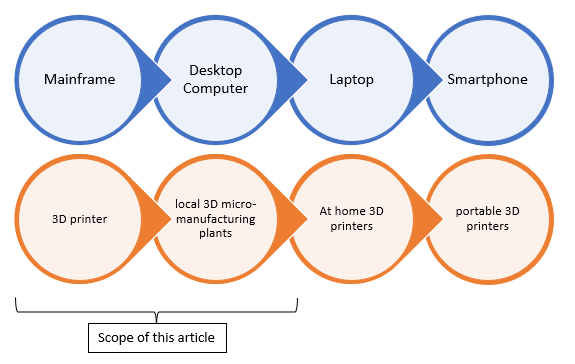Have you already thought of 3D printing your own customized items? Following the framework Clay Christensen, a Harvard business school professor, this might become reality faster than you would expect. Christensen describes in an interview how a mainframe, turned over time into a computer, then laptop, and later even smartphones (Christensen, 2012). He mentions that this new technology becomes more of a commodity over time as first only very prestigious institutions were able to afford a mainframe. What if 3D printing follows the same trend and becomes more and more of a commodity worldwide? This idea seems valid and this article will try to shine a light on the current state of 3D printing, the expected developments, and its effect on the economy.
See Figure 1: possible 3D printer development following the theory of Clay Christensen
Is the current 3D printer the mainframe of the future? While currently 3D printing is on the rise and gaining momentum, it is still in its infancy. However, it has already impacted certain fields. In the most apparent field, manufacturing, it now possible to produce customized items in many different materials significantly faster and for a lower price (Pearson, 2018). Many of you might now think about specific car parts or functional prototypes, however, the techniques are already far more advanced than most of us are aware. In third world countries the first houses have been printed, in the culinary field printing food is on the rise and in the medical field it is now possible to print with living cells to create artificial human tissue (Iconbuild, 2019; All3DP, 2020; Wyss Institute, 2019). What is even more interesting is that 3D printing can create objects that no other manufacturing technique was able to do so far, think for example of 3D printing the intricate structures found within bones (Dodziuk, 2016).
So, what would the effect on the economy be in the long run? While 3D printing might make many jobs obsolete. If we again look back at the theory by Clay Christensen, we can expect that 3D printing becomes more widespread and local micro-manufacturing plants will take over a substantial part of the production. This means that the cost of transporting products will plummet, and warehouses won’t be full of stock anymore as manufacturing becomes much faster, customized, on demand, and regional. While these effects seem quite negative it also opens a whole new world of opportunities (Andy, 2013). Especially when focusing on the current climate challenge. With the changing supply chain lots of energy will be saved at every step of the digital manufacturing and a reduction of the materials used as 3D printing is a form of additive manufacturing instead of subtractive manufacturing (Michalski and Ross, 2014). Moreover, there is an immediate need for 3D printer design, development and manufacturing which means that these companies are gaining market share and employ thousands of new workers each year. Furthermore, the development and distribution of filaments, the ‘ink’ for 3D printers, will become more and more important as these are one of the few products that can never be produced by the 3D printer itself. As producing digital models for the 3D printers is very time consuming, most consumers will buy these models from someone or somewhere else, hence, a market for the creation these models will gain momentum. Lastly, besides the rise of 3D model creators new market segments will arise because of cheaper and faster production. Think for example of the prosthetics industry, where currently waiting times are very long and customization is barely possible. 3D printing would allow for much more consumption within this segment because of lower price points, faster production, and easily modifiable products.
How does it affect the way we do business? 3D printing is expected to make the current market more disruptive than it has ever been before. Anyone who has a great idea for a product can create a 3D model without even needing any resources. Since you are solely selling information at this point the design can be added to any platform and downloaded by anyone who is willing to pay for it. Hence, many small business or self-employed workers get the opportunity to make a living form their work by selling through ‘on-demand’ stores.
All3DP. (2020). 3D Printed Food: All You Need to Know in 2020. [online] Available at: https://all3dp.com/2/3d-printed-food-3d-printing-food/ [Accessed 22 Sep. 2020].
Christensen, C. (2012). Disruptive Innovation Explained. [online] hbr.org. Available at: https://hbr.org/video/2226808799001/disruptive-innovation-explained [Accessed 22 Sep. 2020].
Andy (2013). 3D printing is good news for the economy. [online] 3DPrinterPrices.net. Available at: http://www.3dprinterprices.net/ng-why-3d-printing-is-good-news-for-the-economy/#:~:text=The%20biggest%20negative%20impact%20on [Accessed 22 Sep. 2020].
Dodziuk, H. (2016). Applications of 3D printing in healthcare. Polish Journal of Cardio-Thoracic Surgery, [online] 3, pp.283–293. Available at: https://www.ncbi.nlm.nih.gov/pmc/articles/PMC5071603/#!po=21.3235
Iconbuild.com. (2019). Home | ICON BUILD. [online] Available at: https://www.iconbuild.com/.
Michalski, M.H. and Ross, J.S. (2014). The Shape of Things to Come. JAMA, 312(21), p.2213
Pearson, A. (2018). 10 Advantages of 3D Printing. [online] 3D Insider. Available at: https://3dinsider.com/3d-printing-advantages/.
Wyss Institute. (2019). 3D Bioprinting of Living Tissues. [online] Available at: https://wyss.harvard.edu/technology/3d-bioprinting/.

